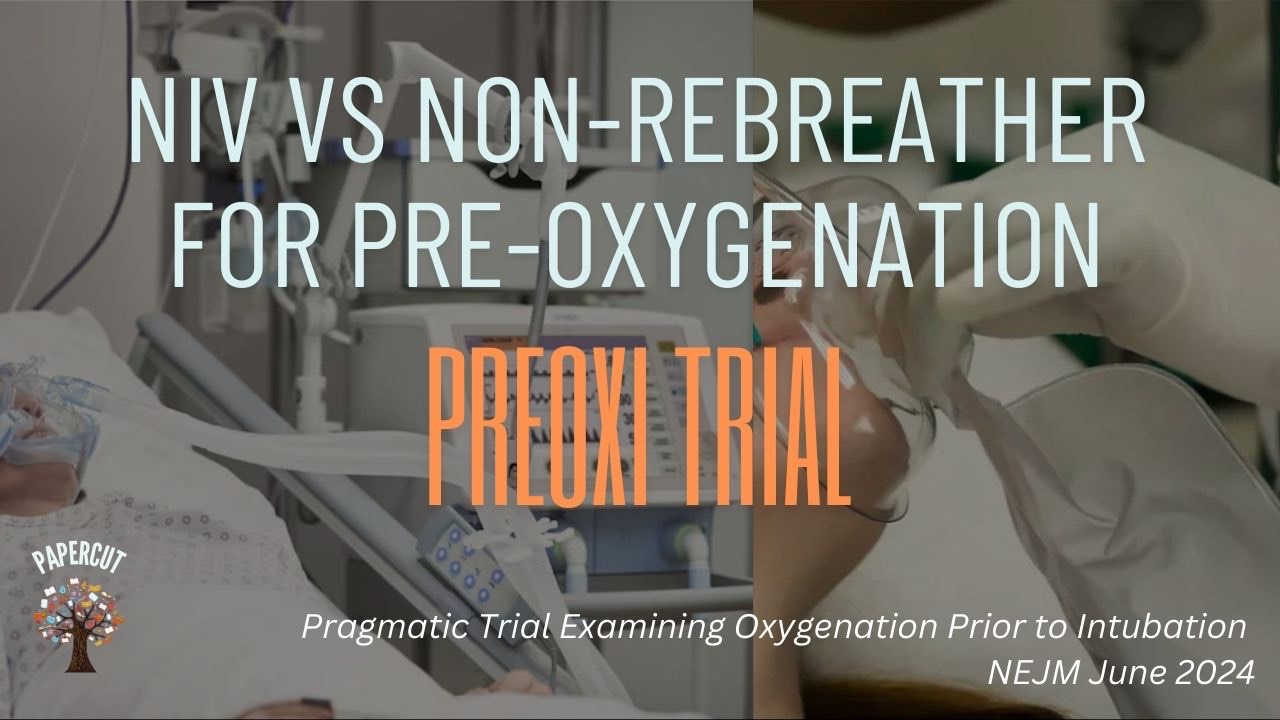This is a review of the Pragmatic Trial Examining Oxygenation Prior to Intubation (PREOXI) trial(1).
The aim of this trial was to determine the effect of preoxygenation with noninvasive ventilation, compared to an oxygen mask, on the incidence of hypoxaemia during tracheal intubation.
The Verdict
This is a large randomised pragmatic trial, that answers a simple question; how does NIV compare to a rebreather mask for pre-oxygenation when we want to avoid intubation related hypoxaemia?
NIV resulted in a significant reduction in episodes of hypoxaemia. It also did not increase the number of episodes of aspiration, which is one of the greatest concerns when using this form of pre-oxygenation.
NIV is my goto, in pre-oxygenation, especially in patients with a high BMI, for which this study also found benefit. This study is practice changing.
What They Did
This was a pragmatic, multicenter, unblinded, randomized, parallel-group trial, conducted at 24 sites (7 emergency departments and 17 ICUs) in critically ill adults, undergoing tracheal intubation.
N = 1301
There was 1:1 randomisation to receive one of two pre-oxygenation treatments:
- Noninvasive-ventilation(NIV) (645 patients 49.6%)
- This was via a tight-fitting mask connected to a conventional mechanical ventilator or a noninvasive ventilator.
- Noninvasive ventilation was delivered at an Fio2 of 100%, from the start of pre-oxygenation until the initiation of laryngoscopy.
- Settings were:
- Expiratory pressure > 5 cm of water
- Inspiratory pressure > 10 cm of water
- Respiratory > 10 breaths per minute
- Oxygen-mask (656 patients 50.4%)
- This was either a non-rebreather mask or bag-mask device without manual ventilation
- Supplemental oxygen was delivered at the highest flow rate available (≥15 liters per minute) from the start of pre-oxygenation until the initiation of laryngoscopy.
Exclusion Criteria included:
- Patients requiring intubation too urgently to complete trial procedures
- Patients already receiving positive-pressure ventilation
- Vomiting, haematemesis, haemoptysis, or epistaxis precluding NIV
- Severe agitation
- Facial fracture or injury
- Severe encephalopathy precluding non-
- High risk of aspiration
- Pregnancy
- Patients with conditions that did not allow use of a mask/NIV
Preoxygenation occurred for at least 3 minutes. Ventilation with a bag-mask device could be provided, based on operator discretion, in either trial group, after induction of anesthesia. A standard nasal cannula or high-flow nasal cannula could also be used to provide supplemental pre-oxygenation to the patients in either group during the time between induction of anesthesia and initiation of laryngoscopy, and between initiation of laryngoscopy and tracheal intubation.
Primary Outcome: Hypoxaemia (saturations < 85%) from induction to 2 minutes after tracheal intubation.
Secondary Outcomes:
- Lowest oxygen saturation between induction of anesthesia and 2 minutes after tracheal intubation.
- Haemodynamic events secondary to positive pressure ventilation;
- hypotension (SBP <65 mm Hg),
- new or increased use of vasopressors, and
- cardiac arrest
What They Found
73.2% of the patients were intubated in ICU and 26.8% in an emergency department in. 85.9% of intubations were performed by a resident or a fellow and operators had performed a median of 50 previous intubations.
Primary Outcome
Hypoxaemia occurred in 57 of 624 patients (9.1%) in the NIV group and in 118 of 637 patients (18.5%) in the oxygen-mask group (P<0.001).
The effect of NIV on hypoxemia was greater among patients with a higher body-mass index
Secondary Outcomes
- Oxygen saturation
- < 80% occurred in 39 of 624 patients (6.2%) in the NIV group and in 84 of 637 patients (13.2%) in the oxygen-mask group.
- < 70% was recorded in 15 patients (2.4%) in the NIV group and in 36 patients (5.7%) in the oxygen-mask group.
- Cardiac arrest occurred in 1 of 645 patients (0.2%) in the noninvasive-ventilation group and in 7 of 656 patients (1.1%) in the oxygen-mask group.
Safety Outcomes
Aspiration occurred in 6 of 645 patients (0.9%) in the NIV group and in 9 of 656 patients (1.4%) in the oxygen-mask group. The incidence of new opacity or pneumothorax on chest x-ray was similar in the two trial groups. Oxygen saturation and Fio2 at 24 hours were similar in the two groups. 38 patients (0.8%) were excluded from the study however, as they were deemed to be too high a risk of aspiration.
Authors’ Conclusion.
“In this trial involving critically ill adults undergoing tracheal intubation in an emergency department or an ICU, the incidence of hypoxemia was lower with pre-oxygenation with non- invasive ventilation than with an oxygen mask.”
References
- Gibbs K W et al. Noninvasive Ventilation for Preoxygenation during Emergency Intubation. June 13 2024; DOI: 10.1056/NEJMoa2313680




